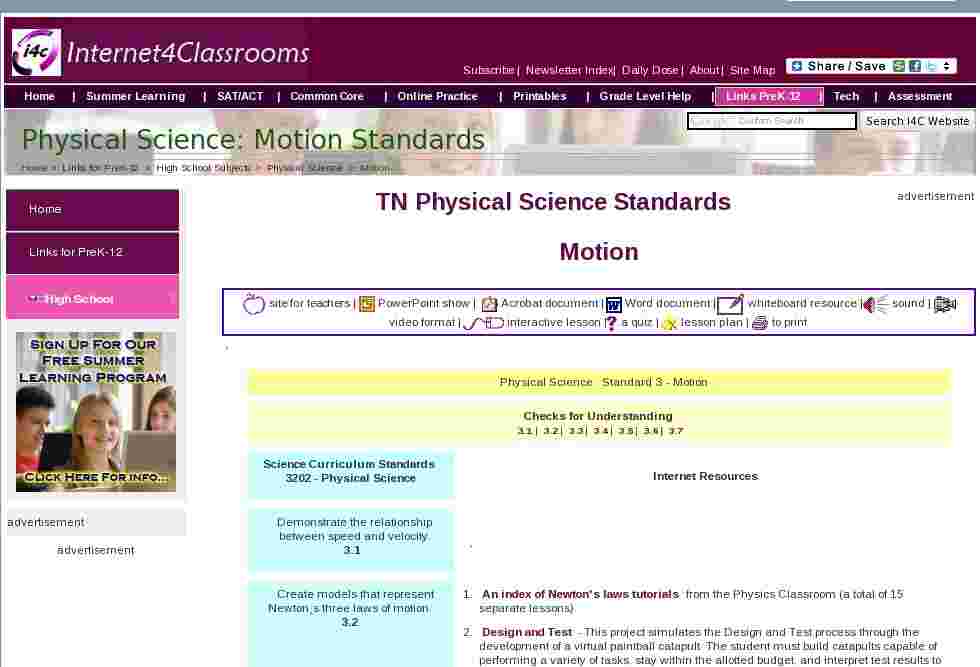TN Physical Science Standards
Motion
site for teachers |
PowerPoint show |
Acrobat document |
Word document |
whiteboard resource |
sound |
video format |
interactive lesson |
a quiz |
lesson plan |
to print
Science Curriculum Standards
3202 - Physical Science
- An index of Newton's laws tutorials from the Physics Classroom (a total of 15 separate lessons)
- Design and Test - This project simulates the Design and Test process through the development of a virtual paintball catapult. The student must build catapults capable of performing a variety of tasks, stay within the allotted budget, and interpret test results to fine tune their design.

- Newton's Second Law Experiment - This Java applet simulates an air track glider setup, as it is used for experiments on constant acceleration motion.
- Motion with Constant Acceleration - This Java applet shows a car moving with constant acceleration

- Mass, Force and Acceleration - Watch as you fill out the chart to see how mass, force, and acceleration are related. When you are done, see if you can write a rule.
- Lunar Lander Simulator - experiment with changing force direction or magnitude

- Momentum - "mass in motion"
- Momentum and Impulse Connection - this tutorial includes a large number of practice questions to check understanding
- The Impulse-Momentum Change Theorem - Real-World Applications
- The Law of Action-Reaction (Revisited)
- Momentum Conservation Principle
- Isolated Systems
- Using Equations as a "Recipe" for Algebraic Problem-Solving
- Using Equations as a Guide to Thinking
- Conservation of Momentum in Different Inertial Frames - One dimensional
- Conservation of Momentum in Different Inertial Frames - Two dimensional
- Speed and Velocity - This Physics Classroom tutorial helps students distinguish between speed and velocity. An animation and two practice problems are included. Follow that lesson with the Acceleration tutorial. Two animations and two practice problems are included with the acceleration tutorial.
- A java applet which allows your students to collect data to make calculations regarding velocity and acceleration due to gravity. Further calculations can be made with a second version of this applet.
- Putt-putt golf applet which asks your students to experiment with velocity and acceleration.
- An index of Newton's laws tutorials from the Physics Classroom (a total of 15 separate lessons)
- Design and Test - This project simulates the Design and Test process through the development of a virtual paintball catapult. The student must build catapults capable of performing a variety of tasks, stay within the allotted budget, and interpret test results to fine tune their design.

- Newton's Second Law Experiment - This Java applet simulates an air track glider setup, as it is used for experiments on constant acceleration motion.
- Motion with Constant Acceleration - This Java applet shows a car moving with constant acceleration

- Mass, Force and Acceleration - Watch as you fill out the chart to see how mass, force, and acceleration are related. When you are done, see if you can write a rule.
- Lunar Lander Simulator - experiment with changing force direction or magnitude

- Describing Motion with Velocity vs Time Graphs - first of five lessons from The Physics Classroom
- Kinematics Equations and Graphs (use of velocity-time graphs to describe the motion of objects) Six practice problems are provided, each requires the student to construct a velocity-time graph. Answers, including graphs, are provided.
- Moving Man Simulation- Learn about position, velocity, and acceleration graphs. Move the little man back and forth with the mouse and plot his motion. Set the position, velocity, or acceleration and let the simulation move the man for you.


Search Internet4Classrooms
 Custom Search
Custom Search
- Site Map |
- About Us |
- Teacher Training |
- Make Internet4Classrooms.com your home page. |
- Copyright © 2000-2024 Internet4Classrooms, LLC All rights reserved.
Use of this Web site constitutes acceptance of our Terms of Service and Privacy Policy.
1743397979354048 US 3 desktop not tablet not iPad device-width